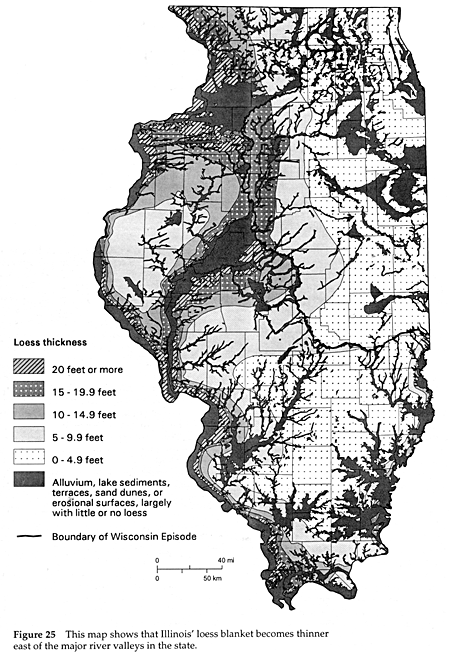The Great Ice Age is Important
to Illinois Agriculture
The first glacier inched its way into Illinois about 300,000 years ago. The fourth and last glacier melted slowly away about 13,000 years ago. The glaciers flattened the land and left behind rich deposits that became the soils on which Illinois farmers have grown their crops for the last 7,000 years. The Illinoan glacier reached into southern Illinois as far as Carbondale. Only the southern tip and the northwest corner of the state were untouched by glaciers.
What Were Glaciers and How Did They Create Soils?
Midwest glaciers formed when the climate grew colder and snowfall did not melt during the summer, but continued to accumulate and crystallize into ice. In Canada this ice layer became up to 8,000 or more feet thick. Under this heavy weight, the ice began to flow outward. Over a long period of time this outward flow reached Illinois.
As a glacier advanced southward, it picked up rocks and boulders in its path, ground them up, and pushed down to the front edge of the ice as it moved forward.
The glacier eventually melted when the climate began to warm. The ice front receded, leaving an average of a 100-foot thick layer of sediment. As the ice sheet melted and receded, this sediment of clay, sand, gravel, pebbles, and rocks was dropped and packed down over the bedrock. It is called till, which is material directly deposited and covered by series of glacial ice sheets. The till was compressed into a heavy but not rock-like consistency.
Another type of deposit is called outwash. As the glacier melted, the water formed streams that flowed away from the face of the ice. These streams carried debris with their current. The heavier debris, such as gravel or sand, sank to the bed of the stream very near the edge of the glacier. The lightweight debris such as silt and clay floated farther downstream.
View this animation of settling of sediment in streams.

When these streambeds dried out, usually in winter, wind picked up fine particles of silt, sand, and clay and scattered it. This silt deposited by wind is called Loess (a German word for crumbly that is pronounced loos, with the oo sound as in book). Loess covers most of Illinois, in some places reaching a depth of more than 20 feet. It is rich in minerals, contains no rocks, and has a uniform texture that retains moisture - all qualities of good soil for growing crops. (map of loess depths).
The Natural Resources Council Service has a large Web site on soils that contains this map of Illinois soil regions:
Other Types of Soil
A type of soil was made by the decomposition of prairie plants that spread throughout Illinois after the glaciers left. This dark, rich soil is called a mollisol. This type of soil, ten inches or more deep, covers almost half of Illinois.
An alfasol is a soil that develops under forest vegetation. The southern third of Illinois is covered with this type of soil. It is less fertile than a mollisol.
A histosol is a soil made from decayed organic material, such as that found in marshes, along riverbanks, and in other wet places. It is common along moraine areas.
Climate and Soils
As the climate changed form an Ice Age into a warmer, drier period, the plant distribution on the land surface changed, too. By 8,000 years ago, the hot, dry climate caused the prairie to encroach on formerly forested areas. As a result, the soils formed from the decomposition of plants would change over time.
As the climate became hotter and drier, there were more fires. The fires
helped renew the prairie plants and control the forest from spreading. The
presence of fires probably had more influence on the health of the prairie
than did climate. (Sauer)







